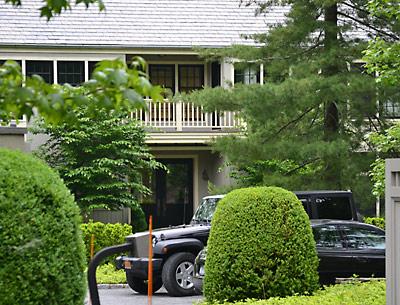Drug Rehab Center Working On Town Deal
Drug Rehab Center Working On Town Deal

A federal lawsuit against East Hampton Town alleging discrimination against the clients of a private residential substance abuse treatment facility in Northwest, filed in January after the town reversed its approval of the operation, has been put on hold so that the parties can negotiate an out-of-court settlement.
Safe Harbor Retreat L.L.C., the owner of the Dunes East Hampton, withdrew its complaint late last week after a judge denied a request by both sides to extend a filing deadline. “The parties are going to try to come to an amicable agreement,” Brian Sokoloff, the attorney for the town in the matter, said Tuesday.
The lawsuit was withdrawn, however, without prejudice, meaning that if a settlement can’t be agreed upon, the matter can again be referred to court.
The Dunes, a high-end, private-pay-only center, has been treating clients with drug and alcohol addictions since 2010. Before it opened its doors, it was endorsed by then Supervisor-Elect Bill Wilkinson, now serving his second term in office, and got a go-ahead from Tom Preiato, the town’s acting chief building inspector.
Based on descriptions submitted by Safe Harbor Retreat about how the center would operate, Mr. Preiato determined that the residents would be functioning as a family unit, thus allowing the residential property to be used for the center.
But, the lawsuit against the town alleges, Mr. Preiato reversed his decision after the town received a complaint from George Meredith, the owner of the Seafield Center, another private treatment center, in Westhampton Beach. The reversal requires the Dunes to submit a site plan application and obtain a special permit from the town planning board in order to operate legally on its rented residential property at 26 Bull Run.
The lawsuit claimed that the effect of that decision violates the federal Fair Housing and Americans With Disabilities Acts, as well as the Constitutional due process clause, by threatening to deny housing opportunities to recovering alcoholics and substance abusers in East Hampton, discriminating against them, and causing them distress and setbacks in their efforts at recovery.
Neighbors of the rehab house, meanwhile, have hired an East Hampton attorney, Jeffrey Bragman, to make their case that use of the property by the Dunes should have been subject to planning board review.
Frustrated that the town has not compelled the Dunes to submit a planning board application and has allowed it to continue operating since Mr. Preiato’s new ruling last September, Mr. Bragman, on behalf of Anthony Liberatore of 20 Bull Run, sent a letter to town officials last week putting them on notice that “in the absence of appropriate town action to enforce zoning, New York State Town Law . . . authorizes the initiation of taxpayer litigation to do so.” Mr. Bragman said this week that the residents could seek an injunction to shut the Dunes down.
According to the lawsuit, Joseph McKinsey, the founder of the Dunes, met with Mr. Wilkinson in December 2009, just before Mr. Wilkinson took office, and the supervisor-elect expressed his support for Mr. McKinsey’s plan.
In February 2010, according to the narrative submitted to the court, Mr. McKinsey met with Mr. Preiato to advise him of his plans. In a letter sent to the Building Department later that month, Mr. McKinsey asked that the town make a determination that the center’s residents would be considered the “functional equivalent of a family,” allowing the facility to operate in a residential zone without first obtaining a planning board permit.
Early in March of that year, Mr. Preiato issued a determination that the plan met the town’s zoning code requirements. A 60-day period, during which any challenges to zoning determinations must be made, passed with no challenges submitted.
According to the lawsuit, Safe Harbor Retreat, “as a result of Mr. Preiato’s determination,” spent approximately $2 million “to establish 26 Bull Run as a residential treatment facility.”
In July 2010, a letter signed by Supervisor Wilkinson, John Jilnicki, the town attorney, and East Hampton Town Police Chief Eddie Ecker was submitted to the New York State Office of Alcoholism and Substance Abuse Services in support of Safe Harbor Retreat’s state license application. The license was issued, and the rehab center opened on Nov. 20, 2010.
The lawsuit says that in November 2010 and again the following summer, town officials toured the facility and “continued to show their support.”
However, according to the suit, in September of last year, the town’s director of public safety, Patrick Gunn, met with Madeline Narvilas, Safe Harbor Retreat’s executive director and a former East Hampton Town attorney, and told her that, following an article about the facility in The New York Post, there had been a complaint.
The sole complainant, the lawsuit alleges, was Mr. Benedict, the Seafields owner. Mr. Gunn, the lawsuit says, asked if the Dunes would consider applying for a special permit and site plan approval from the town based on a “change of use.”
An attempt to reach Mr. Meredith was referred to Mark Epley, Seafield’s executive director, who is also the Southampton Village Mayor. Mr. Epley did not return a call for comment by press time.
Mr. Bragman, who represents 30 neighbors of the Dunes, said Tuesday that he believes the nature of the center was misrepresented to the town at the start. It was portrayed, he said, as more of a “sober house,” where a group lives together for mutual support, versus as a residential treatment center that provides counseling and other clinical services.
In letters to Mr. Preiato as well as to the state licensing agency, Mr. McKinsey stated that only “nonclinical” services would be offered at the house, and that residents would go elsewhere for treatment.
The center’s Web site indicates otherwise, Mr. Bragman asserted Tuesday. “The neighbors have on occasion heard therapy sessions they’ve had outdoors,” he said. “There’s a pretty serious amount of critical care going on there. It’s not just a house.”
In addition, he said, “there’s a lot of coming and going,” prompting complaints from nearby residents about traffic and noise. “This thing is impacting a neighborhood; the neighbors have never had a public hearing. ”
The initial support of the town board and other officials, Mr. Bragman said, “short-circuited a process that otherwise exists. The critical thing is getting that neutral, predictable working process of planning review.”
The Dunes’s submission to the court says that in late September of last year, Mr. McKinsey received a letter from Mr. Preiato telling him that upon further review of the operation of the facility, “namely the providing of on-site addiction treatments and services, as well as the transient nature of your clients’ varied residencies at the facility, it is now clear that such an operation is not permitted in a residential zone without site plan approval.” He said the Dunes could be classified as a “semi-public facility.”
A semi-public facility designation does not rule out a location in a residential zone. However, the planning board must approve such a use, and issue a special permit for it, after first considering potential impacts to the surrounding neighborhood.
Mr. Preiato apparently followed up his September letter with another to Mr. McKinsey, in early November, saying that the matter required immediate attention.
A counsel for the Dunes wrote back later that month questioning the basis for Mr. Preiato’s conclusion.
The standoff continued, until, the lawsuit says, Mr. Preiato appeared at the center in January and asked to inspect it. Ms. Narvilas, it says, told him that any contact should be through the center’s attorneys.
Later that month, after correspondence between the parties, Mr. Jilnicki informed the center’s lawyer of his support for Mr. Preiato’s position and said that the building inspector would be “proceeding with appropriate efforts to enforce the requirements of the East Hampton Town Code.” Safe Harbor Retreat, a k a the Dunes, filed suit in federal court on Jan. 25.
The lawsuit asked the court to keep the town from taking any action that would interfere with the continued use of the house by the Dunes; to declare that the town has “illegally discriminated” against the Dunes “by arbitrarily and capriciously applying its zoning, building, and property maintenance codes” to the site, thus violating the housing and disabilities acts, and Constitution; to issue an order stating that the plaintiffs’ use of the house is consistent with town zoning, and to award compensatory damages and costs.
In a statement issued yesterday, Mr. Gunn said “no charges have been filed on this property, however, with the assistance of outside counsel, the town has been engaged in negotiations to resolve the matter through voluntary compliance. It is the town’s position that Safe Harbor Retreat, in its current operational form, requires [a] site plan and special permit and [zoning board of appeals] setback relief. Because of potential litigation and the sensitive nature of the negotiations, no further information will be forthcoming, other than that our expectation is for resolution very soon,” he said.









